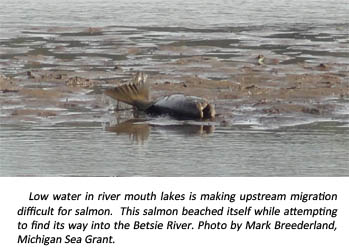End of dry spell could put salmon on the move
Salmon anglers in west Michigan rivers and many river mouth lakes have had tough fishing this season due to low water levels and high water temperatures. A change in weather should send more fish into rivers, but conditions are likely to remain difficult.
After a fairly dismal beginning to salmon runs that usually ramp up in late August, west Michigan rivers are beginning to see better numbers of fish. In Grand Rapids, coho salmon were caught on video as they made their way upstream along with a few Chinooks, brown trout, and steelhead. A mix of species has also been seen moving on the Michigan DNR’s Fish Cam at Berrien Springs on the St. Joseph River.
In rivers farther to the north, surface water temperatures in Lake Michigan have been low over the past week and better numbers of Chinook salmon have been attempting to make their way into rivers such as the Pere Marquette and Manistee. Anglers can use the Coastwatch website for daily updates on surface water temperatures in Lake Michigan. When north or east winds push warm water offshore, cold-water upwellings bring more salmon close to pierheads and river mouths.
Low water in both Lake Michigan and its tributaries has been problematic for salmon this year. Salmon often stage in river mouth lakes such as Muskgeon Lake, Pere Marquette Lake, and Betsie Lake before running upriver to spawn. Rivers carry sand, silt, and organic matter that falls out of the water column in river mouth lakes to create shallow flats. Water levels are so low this year that some flats are dry in areas and too shallow for fish to easily navigate.
 Some salmon on the Betsie River have been beaching themselves in attempts to ascend the river, and their vulnerability to harvest has led to a special closure of the area to fishing as of October 10. The high water temperature puts additional strain on Chinook salmon, which will tolerate water temperatures above 70 degrees Fahrenheit if oxygen levels are adequate although their optimum migration temperature is 57-61F.
Some salmon on the Betsie River have been beaching themselves in attempts to ascend the river, and their vulnerability to harvest has led to a special closure of the area to fishing as of October 10. The high water temperature puts additional strain on Chinook salmon, which will tolerate water temperatures above 70 degrees Fahrenheit if oxygen levels are adequate although their optimum migration temperature is 57-61F.
In Muskegon Lake, boat anglers typically find Chinook salmon beginning their run a couple of weeks later than rivers farther north because Muskegon Lake is a large body of water that takes a long time to cool as fall approaches. Anglers can now check real-time conditions at the Grand Valley State University buoy in Muskegon Lake, which currently shows 66F in thirty feet (9 meters) of water and low oxygen conditions in deeper water.
Even if conditions do improve with cooler weather and rain over the next week, the long and dry summer has taken a toll on upstream habitat. Without powerful current to scour sand and other sediment from holes, some of the best holding areas and fishing spots in certain rivers have partially filled in over the summer.
Shallower holes, lower river levels, and clear water all lead to spooky salmon and difficult fishing. Salmon do not feed after entering rivers to spawn, but they can be tempted to bite out of aggression, habit, or attraction to the scent of eggs. With no need to feed, their protective instincts often prevail under low-water conditions and fish quickly become ‘stale’ after entering the river.



 Print
Print Email
Email

